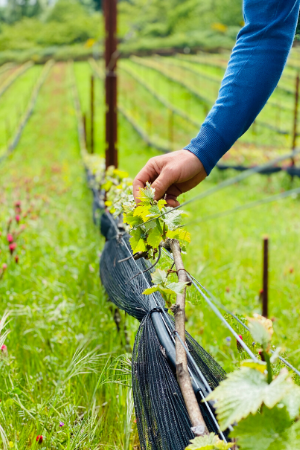May 15, 2020 | Alex Moro
May in the Vineyard

This time of year it's hard to ignore the buzzing of activity and birdsong all about. Flowers reveal their best show in an effort to attract pollinators and our eyes alike. Grape vines neatly tied to the trellis wire unfurl from a tender pink-green bud into the rising promise of abundant clusters and fermenting juice.
 Our immediate task is to thin the new shoots on each plant down to a spacing roughly a fist width apart. Too many shoots on a cane results in a dense canopy impenetrable to sunlight or airflow, heightening the risk of powdery mildew and unripe fruit. Too few might space out the canopy nicely but won't result in much fruit come harvest.The healthiest, most vigorous shoots are chosen and smaller secondaries from the same bud are plucked off.
Our immediate task is to thin the new shoots on each plant down to a spacing roughly a fist width apart. Too many shoots on a cane results in a dense canopy impenetrable to sunlight or airflow, heightening the risk of powdery mildew and unripe fruit. Too few might space out the canopy nicely but won't result in much fruit come harvest.The healthiest, most vigorous shoots are chosen and smaller secondaries from the same bud are plucked off.
Shoot thinning is also a chance to better know each variety in the field. Our Pinot Noir is notorious for pushing out an abundance of closely spaced buds and secondary shoots in May which must be pared back to manage a predictably prodigious canopy. On the other end of the field near grazing Soay sheep sit Garanoir with steady spaced shoots requiring very little adjustment. Indeed, its canopy is so delicate and lacey that it is left perfectly well alone most of the year without the need to thin leaves or hedge at all.

While passing down each row the temptation to remove pesky trunk suckers is unbearable, and this is good practice when time allows as they will draw energy away from fruiting shoots and ripening clusters. Yet, there are always more opportunities to do the housekeeping as suckers continue to pop up with the insistence of spring. Time to keep moving, to keep apace.
Spring fever is abundantly apparent by the returning presence of a dull hum in our fields: the sound of insects and pollinators seeking nectar from our winter cover crop. And soon, the sound of our mowing into green manure returning nutrients and organic matter to the soil. Interspersed within the bold carpet of crimson clover are poppies, purple vetch, rye, and wheat. A profusion of lady beetles are visible climbing among the bare trunks and canes. Their presence is indicative of the insect diversity fostered by our cover crop and will serve to keep our pest population in check.
Below the surface, a thick root mass exists strengthening the resilience of our living soil, retaining water, and home to many beneficial bacteria and mycorrhizal fungi critical to supporting the health of our vines. For, though our crop hangs from the vine, its journey to that perfect fruit begins deep down at a microscopic site called the rhizosphere – a good topic for another day and another glass.
--Alex Moro
You can read more about our vineyard in our Visit Us section. Sign up for our newsletter below to learn more about our wines, events, sustainable practices, and more. For all questions and inquiries, please email contact@porttownsendvineyards.com